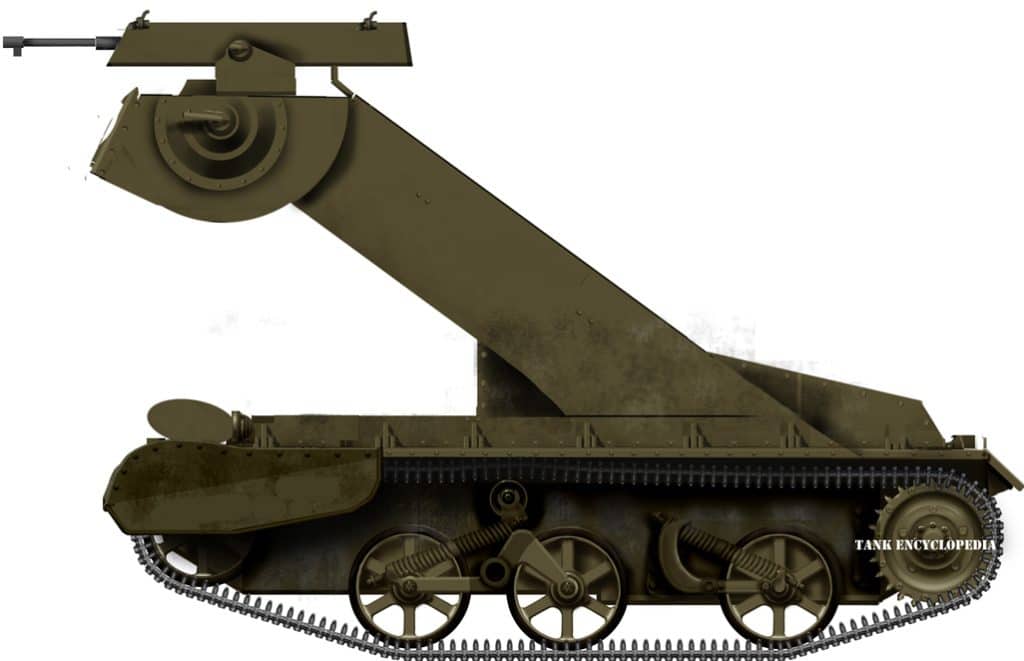
LSA .276 self-loading rifle
This rifle was submitted to the Small Arms Committee in 1910, and was developed by Thomas R. Ashton of London Small Arms. It was recoil-operated with a tilting bolt which was engaged by a wedge in the rear interior of the receiver. The chambering was in .276 Enfield and the gun was fed by detachable SMLE-type magazines (there seems to have been no clip-feed guide). The LSA rifle gave bad tests and was considered particularly susceptible to sand and dirt, a common flaw of early self-loaders. It was rejected and no further action was taken.
The use of SMLE-pattern components such as the magazine gives this rifle some compatibility with the standard British service rifle. It would be interesting to see a hypothetical .303 version adopted in limited quantities by the British in about 1915 - 1916 to provide troops with an infantry automatic weapon. Most other militaries in the war investigated the concept of providing increased individual firepower to their troops - the French with the Chauchat & RSC, the Germans with the M.P.18,I, the Austrians with the M.12/P16 & Sturmpistole, and the Italians with the Villar Perosa & Revelli-Beretta. The closest the British had was the Lewis gun. While there is little chance that the LSA rifle would've been able to cope with the mud of the Western Front, possible roles for the rifle could be an aerial observer's weapon or a marksman rifle.
(Side note: I like to imagine that this rifle would've been nicknamed the "Lisa" if it were adopted.)

BSA-Norman 7x63mm inclined bolt rifle
The BSA-Norman was designed by George Norman of BSA in 1911. The concept of this gun was to employ an inclined bolt which ran at a lower angle to the firer's eyeline, so as to allow the user to cycle the bolt whilst remaining sighted on their target. The bolt face was a separate piece that did not rotate with the bolt, and the bolt guide ran down the comb of the stock. Interestingly the rifle was chambered for a proprietary rimless cartridge, 7x63mm Eley. I don't know of any other guns that were chambered in this round. The cartridge proposed as a possible replacement for .303 but the British Army were more interested in .276 Enfield.
The BSA-Norman rifle was trialed briefly in March 1913 and reportedly gave a "disastrous" performance. Neither the concept nor the cartridge were developed any further, and priority was given to other projects such as the .276 Pattern 13 rifle.

A British SMG in World War I?
In October 1915 an Italian representative, Dr. Bernachi, went to Britain to demonstrate their new 9mm "Pistola Mitragliatrice". It was tested at Hythe and Enfield and the examining officer from the Small Arms Committee, calling it the "Villar Perosa machine-gun" (first recorded use of that name), described it as "two long-barreled automatic pistols connected together", adding that it was "very suitable for trench work". A proposal was sent to the General Headquarters in France asking if such a weapon was required by British troops but the GHQ did not notice the value in the concept that the SAC had picked up on. The subsequent year, a unique variant of the Villar Perosa chambered in .455 Webley Auto was sent to Britain for testing, but by this time the GHQ was already set against the idea and it was not investigated any further.
Had the GHQ not been so quick to dismiss the Villar Perosa, the .455 model could've led to something more - adoption in its current form was unlikely, but the British could've adapted the gun into something like the Italian Revelli-Beretta carbine or the O.V.P. submachine gun:
Use of a .455 SMG by British "stormtroopers" in 1916 is perhaps wishful thinking. But a .455 O.V.P. could have been a pretty handy weapon for pilots and aerial observers, as the Italians themselves noticed when they issued their 9mm O.V.P. to airmen in 1918. On the other hand, a semi-automatic .455 carbine in the style of the Italian Revelli-Beretta would have been a suitable gun for "non-tooth" personnel who were not issued a rifle. Britain was in fact the only major combatant in World War I not to develop a submachine gun (except perhaps the Ottomans).
BSA-Király machine carbine
The BSA-Király machine carbine came about as a collaboration between BSA and the Hungarian designer Pál de Király, with Mark Dineley acting as the middleman between the two parties. It was proposed to the War Office in May 1939 and a small batch of prototypes were produced by BSA for trials, including a short-barreled model and a long-barreled model. Essentially the gun was derived from the SIG MKMO submachine gun for which Király had done some design work, mainly in the use of a lever-delayed blowback action which gave a fire rate of 730rpm. It was chambered in 9x25mm Mauser Export and took MKMO magazines. The trigger mechanism was remarkably complex, using a flywheel and spring, but Király suggested that this could be replaced by a simple sear if the gun were to go into full production. Dineley also suggested that a production version should incorporate the MKMO's folding magazine. BSA quoted a price of £5 per unit.
A production version of the BSA-Király probably would've looked something like the Danuvia SMG adopted by the Hungarians in 1939:

The BSA-Király was tested briefly by the Ordnance Board in 1939 but no interest from the British Army materialized and the concept was not revived in 1940 - possibly because of difficulties over securing the rights from Király. In any case, this was probably the Army's best option prior to WWII. It was high-quality, based on a proven design, and above all reasonably-priced, especially compared to other contemporary SMGs. BSA were ready to manufacture the gun in 1939 and it been adopted in September, hundreds could've been ready for issue to the BEF by May - June 1940. Possible name - "BESAK" (similar to "BESA", but with -Király added as a suffix).
The British "Schmeisser"
The story of the British scramble to adopt an SMG after Dunkirk is fairly well-known by now, with the results being the Lanchester and Sten machine carbines, which were both essentially derived from the German M.P.28,II submachine gun. Lesser-known is a proposal by the Air Ministry for 10,000 British-made copies of the "Schmeisser" - the MP 38. BSA went so far as to draw up the plans for such a gun. But it was never made, trumped by a similar proposal by the Admiralty for a copy of the M.P.28,II (which became the Lanchester). Why the Ordnance Board decided to grant the Admiralty's request instead of the Air Ministry's is pretty inexplicable, as the MP 38 was significantly cheaper to manufacture than the M.P.28,II. The Ordnance Board had even been made aware of the MP 38's efficiency as early as May 1939, when the Director of Artillery informed the OB that "1,000 of this make could be procured at very short notice". If the Ordnance Board had heeded this advice, the Royal Navy and the RAF could have been issued BSA-made MP 38s throughout the course of the war. Adoption by the Army was probably less likely given their commitment to the Sten gun.
A British "assault rifle" in 1940?
Almost immediately after the BEF got to France in December 1939, they sent a request to the Ordnance Board asking for an immediate supply of "machine carbines or gangster guns" (i.e. submachine guns). Field trials were arranged in which the Ordnance Board sent over seven trial SMGs which included the Hyde, Thompson, Steyr-Solothurn, and Suomi. Also very interestingly, instructions were given to RSAF Enfield to convert several self-loading rifles to give automatic fire. The rifles in question were the Johnson rifle of 1938, the ZH-29 from Czechoslovakia, and an as-yet unidentified prototype known as the "Y.S.L." These were supposed to offer a potential substitute for an SMG.
Trials were also arranged to test the Lightened Lewis and Soley-Lewis machine-guns in the role of a hip-fired MG. The BEF liked the Finnish Suomi gun the best but for obvious reasons there would be difficulty in procuring it. The Steyr-Solothurn gun was also unavailable due to Austria's annexation and the Hyde was not in production. This really left the Thompson as the only viable choice, and by February 1940 the British Purchasing Commission placed an order for 450 Thompsons (which raised to 107,500 by December). Interestingly the OB initially recommended that the Thompson be adopted in .380 caliber, but this was not followed through.
Any other weapon concepts that you'd like to have seen capitalized on?





